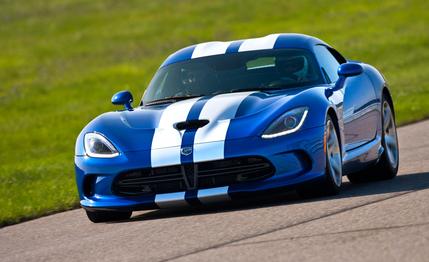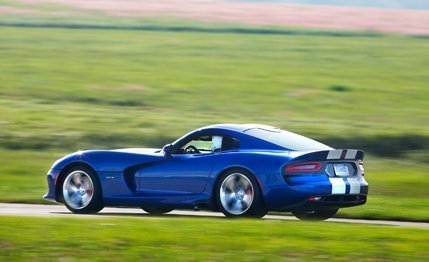
 First Drive Review
First Drive Review


The Viper is back, new and vastly improved after more than two years in stasis. Chief among the tweaks to the fifth iteration of the new SRT brand’s headline supercar (it’s no longer a Dodge) are a more upscale interior and increased creature comforts. Has the Viper gone soft? In a single word, no. But after a half-day sneak preview at GingerMan Raceway in South Haven, Michigan—where we previously captured some shakedown images and video—we can say with confidence that the new Viper is not only better than ever but is finally as appealing in person as it is on paper.
A Quantum Leap, Albeit without Scott Bakula
At a distance, the Viper looks a lot like the previous car, and the two even share the same windshield. But up close, the new car is far more elegant. There are no hard creases despite some sharpish features, and the hood gives off a menacing vibe reminiscent of something dreamed up by H.R. Giger. In comparison, the previous-generation Viper looks dated, even clumsy. There are two Viper models, base and GTS, most obviously differentiated visually by the number of hood vents; the uplevel GTS has only two versus the regular car’s six. Every vent or scoop is functional on both models, from the rear brake ducts behind the side windows to the outboard inlets in the front fascia that funnel a drag-reducing curtain of air around the front wheels.


The old Viper SRT10 is on hand to help make dynamic comparisons, and driving it definitely brings back memories, the most dominant of which is that it was kind of a pain in the ass. You don’t get behind the wheel so much as you contort your body into something resembling a driving position. Visibility is poor, and the passing of time has only made the rental-grade interior look even more appalling. As for the chassis, a few laps around GingerMan remind that the old Viper’s high limits are best approached with caution.
Slide into the new Viper, and it’s hard to believe it’s just three model years removed from its predecessor. Soft leather and vinyl replace hard plastic. The thin, firm seats (supplied by Sabelt, which also counts Ferrari among its customers) immediately feel more comfortable and are more adjustable. They’re mounted an inch lower, resulting in more headroom and a roomier overall feel. The center tunnel is lower, putting the shifter in a more natural position that allows you to change gears more with your wrist than your forearm. And the cabin is less of a sweatbox now that the exhaust doesn’t cross over below the occupants, although the threat of seared calf flesh remains—the pipes run only along the side of the body, but they still heat up the rockers and terminate behind the doors.
As Able as Ever—and Less Intimidating
Improvements extend beyond ergonomics and into the chassis. A revised steel frame and an extruded-aluminum X-brace that spans the engine bay increase stiffness by a claimed 50 percent. The front track is pushed out, and the front tires are wider by 20 mm. At the rear, rubber engorged by 10 mm (Pirellis that now measure 355/30-19) shrouds a revised suspension with a relocated toe link and softer anti-roll bar. The changes are immediately noticeable on the track. Steering loads increase more naturally in concert with cornering forces, and turn-in is more immediate. But mostly, the Viper feels more stable, more confidence-inspiring. The front now leads the rear axle through a corner, a contrast with the impression in the old Viper that the two are fighting each other for control of the car’s vector. Breakaway behavior, via brake-induced understeer or throttle-induced oversteer, is now entirely predictable. The limits are even higher than before, but this Viper is easier to drive quickly.